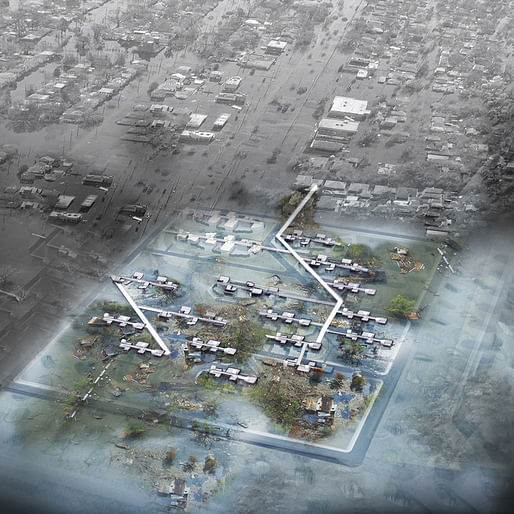

With strange weather patterns becoming the norm, who knows when or where the next natural disaster will strike and affect local neighborhoods. And architects are trying to work with nature to find effective and economic solutions in disaster rebuilding. Some of those architects include Ida D.K. Tam of the diji-lab — a Building Information Modeling (BIM) and digital design consultancy in New York City — in collaboration with Runsheng Lin and Julia Pascutto.
The team investigates the possibilities to integrate BIM, digital simulation technology, and natural systems in an effort to mediate floodwater damage in the context of New Orleans.
Keep reading for a more detailed summary of the project:
"Owing to the inseparable links between nature, performance and efficiency, it is time that digital simulation, building information modeling technologies and natural systems play larger roles in design and construction.
Reversed tributary housing system is an ecological flood water management oriented housing strategy that operates on multiple levels - trying to marry the logic of natural tributary organization to the efficiency of fluid dynamics, to derive the optimal formal organization and aggregation under the impact of flood water. Instead of building to resist disaster, the system is building to embrace."

"Digital Simulation
By inverting the logic of how a river basin works, the system mediates the damage of flooding in three folds:
1. Channeling and re-orientation: More tributaries at the direction of flood water, less branches inland, increase surface storage, to allow maximum time for infiltration into soil and pumping. The arrangement of urban grids should be re-orientated and rotated against the direction of flooding to facilitate maximum resistance towards flood water.
2. Teardrop shape block: To minimize damage of flood water, digital stimulation of flooding scenarios should be carried out to search for an optimized fluid dynamic form
3. Hybrid structure: Many storm-resist designs respond by making the structure float or build with stronger material. However in the scenario of storm surge and tsunami, waves come in such great speed that either the floating speed of the structure or the structures are already damage by debris before it could react.
Therefore it is economically irrational and impractical attempting design a building to resist. A hybrid structure: a permanent frame and core structure that ensure safety and allow rapid rebuilding, and prefabricated facades system that have short life span and built to be destroyed in strong surges, would allow storm proof technology affordable to the general mass, easy and speedy replacement for post disaster recovery."
"Pre-flooding strategies operates on two scales. On urban scale, the strategy is to apply the notion of inverted logic of river tributary organization. An urban aggregation that increases density from coastal to inland is created, resulting in more surface storage, maximizing time for infiltration into soil and pumping. To minimize damage of floodwater, urban blocks are designed to follow fluid dynamics principles."
"After a series of forms are being tested under digital simulation of different flooding scenarios, a rationalized faceted teardrop shape urban block form is utilized, balancing the factors of ease of construction, economic of scale and flood resistant performance. The grid is then rotated to act against the direction of flood water, and overlay with transportation network for further resolution. Utilities such as electricity cables, water pipes are elevated in structures above ground to minimize damage from flood water and allow for quick repair."
"Building Information Modeling
In order to accelerate reconstruction and control rebuilding costs effectively, there must be efficient coordination in the transition among the phases of schematic design, design development and construction phase. Project data and information must be well managed, potential conflicts must be identify in early stages of the design, and building information modeling is the essential tool to achieve this goal is a must. Building Information Modeling (BIM) integrate all architectural information into one single three-dimensional model, it also incorporate three-dimensional information from landscape architects, structural, civil and mechanical engineers. It provides a collaborative platform to managing the project at all stages and could save project costs up to 35%-75%.
Building Information Modeling allows the prefab and pre-detailed facades panel of hybrid structure to directly streamlined in the manufacturing process, transported from the factories to site, potential eliminating the cost of hiring engineer and high-skilled labor, rebuilding the units with maximum efficiency."
Click the thumbnails below for more images.
No Comments
Block this user
Are you sure you want to block this user and hide all related comments throughout the site?
Archinect
This is your first comment on Archinect. Your comment will be visible once approved.